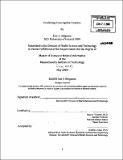Predicting prescription patterns
Author(s)
Helgason, Ívar S. (Ívar Sigurjón)
DownloadFull printable version (6.286Mb)
Other Contributors
Harvard University--MIT Division of Health Sciences and Technology.
Advisor
Staal A. Vinterbo.
Terms of use
Metadata
Show full item recordAbstract
Electronic prescription software is replacing traditional handwritten medication orders. This development however doesn't come without a cost and speed has been one of the most complained about issues. It is important to address this problem and develop methods to reduce the time spent entering medication orders into computerized prescription software. The objective of this study was to understand the structure of prescription patterns and explore the possibility of designing a method that will predict prescription patterns with only the knowledge of past prescription history. Various machine-learning methods were used and their performance measured by the accuracy of prediction as well as their ability to produce desirable results, within practical time limits. This paper presents a method to transform prescription data into a stochastic time series for prediction. The paper also presents a new nonlinear local algorithm based on nearest neighbor search. In analyzing the database the drug patterns were found to be diverse and over 30% of the patients were unique, in the sense that no other patient had been prescribed the same set of active ingredients. In spite of this diversity, it was possible to create a list of 20 drugs that contained the drug to be prescribed next for 70.2% of patients. This suggests that probabilistically created pick lists, tailored specifically for one patient at the time of prescription, might be used to ease the prescription process. However, further research is needed to evaluate the impact of such lists on prescription habits.
Description
Thesis (S.M.)--Harvard-MIT Division of Health Sciences and Technology, 2008. Includes bibliographical references (leaves 43-49).
Date issued
2008Department
Harvard University--MIT Division of Health Sciences and TechnologyPublisher
Massachusetts Institute of Technology
Keywords
Harvard University--MIT Division of Health Sciences and Technology.